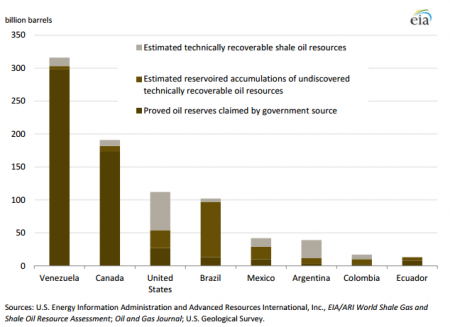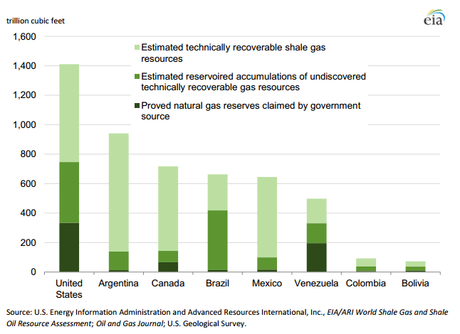 Americas proved oil reserves and recoverable oil resources. (Source: U.S. Energy
Americas proved oil reserves and recoverable oil resources. (Source: U.S. Energy Information Administration and Advanced Resources International, Inc., EIA/ARI World Shale
Gas and Shale Oil Resource Assessment; Oil and Gas Journal; U.S. Geological Survey)
The report, called “Liquid Fuels and Natural Gas in the Americas“, examines the major energy trends and developments of the past decade in the Americas, focusing on liquid fuels and natural gas—particularly, reserves and resources, production, consumption, trade, and investment.
The Americas, which include North America, Central America, the Caribbean, and South America, account for a significant portion of global supply, demand, and trade of both liquid fuels and natural gas. Liquid fuels include all petroleum and petroleum products, natural gas liquids, biofuels, and liquids derived from other hydrocarbon sources.
In 2012, the Americas produced 29% of the world’s liquid fuels supply, at almost 26 million barrels per day (bbl/d), and consumed one-third of the world’s liquid fuels, at nearly 30 million bbl/d. Combined, the countries in the region imported and exported substantial volumes of both crude oil and refined petroleum products, accounting for 25% of global crude imports, 9% of global crude exports, and 22% of global petroleum product imports and exports. The countries in the Americas imported 4 million bbl/d and exported 3 million bbl/d of refined petroleum products in 2012, much of which was exported from the United States.
For much of the past decade, the United States has been a major crude oil, petroleum product, and natural gas trading partner with other countries in the Americas. From 2003 to 2012, the United States imported about 5 million bbl/d of crude oil from other countries in the region—primarily from Canada, Mexico, and Venezuela. However, the quantities and shares of imports from those countries are shifting. With U.S. crude oil production continuing to increase, domestic production has displaced some imports of crude oil, including those from Latin America, defined as Mexico plus Central America, the Caribbean, and South America.
The United States has been a major petroleum product supplier to the Americas for the past decade, and its significance as a product supplier has grown considerably in recent years. In 2003, the United States exported 0.6 million bbl/d of petroleum products to other countries in the Americas, primarily Mexico and Canada. In 2012, U.S. exports to the countries in the region totaled 2.0 million bbl/d, still primarily to Mexico and Canada but increasingly to other countries, most notably Brazil and Chile. As a result, the United States recently became a net exporter of petroleum products.

Americas natural gas reserves and resources, 2012. (Source: U.S. Energy Information Administration and Advanced Resources International, Inc., EIA/ARI World Shale Gas and Shale
Oil Resource Assessment; Oil and Gas Journal; U.S. Geological Survey)
Refined product trade in the Americas has changed as demand in Latin America (the Americas excluding the United States and Canada), including demand for cleaner, low-sulfur products, has grown faster than local refinery capacity. U.S. refineries on the Gulf Coast, where some of the most sophisticated and economic refining capacity in the world is concentrated, have been well positioned to provide additional supply to meet this growing demand.
In 2012, the Americas produced and consumed about 31% of the world’s natural gas, both at 37 Tcf, while accounting for 20% of global natural gas trade in both imports and exports, both at 6 Tcf. More than 80% of both natural gas imports and exports in the Americas were transported via pipeline to neighboring countries, while the remainder was traded within the region as liquefied natural gas (LNG). The U.S. Energy Information Administration (EIA) expects natural gas exports from the Americas to increase further as natural gas supply, particularly in the United States, continues to rise as shale gas production increases. Additional LNG terminals and the ongoing Panama Canal expansion, which will allow passage of larger LNG tankers, will further boost LNG exports in the Americas region.
Recognizing the abundance of hydrocarbon resources in the Americas and the availability of technical capabilities to produce them, companies within and outside of the region have invested heavily in developing and producing liquid fuels and natural gas. Both international oil companies (IOCs) and state-owned oil companies in the Americas have made the most substantial investments, followed by companies based in Europe and in Asia and Oceania.
Foreign investment in the region has been concentrated in those countries with legal and regulatory structures open to foreign involvement. Countries with the most open structures like Canada, Brazil, Colombia, and the United States have attracted significantly more investment than others in the region. Mexico, which recently adopted new energy reforms that allow some types of foreign private investment in the energy sector, looks to join their ranks.
Asian investment in the region has risen dramatically in the past five years, in particular, investment by China’s national oil companies to secure both crude oil supplies and physical assets, such as refineries, especially in those countries considered to have more restrictive foreign investment laws and regulations.
The Americas region holds an abundance of existing proven reserves, as well as the promise of abundant resources of both oil and natural gas. While the Americas have accounted for a considerable portion of the global markets in liquid fuels and natural gas and have attracted sizeable investments, the region has the potential for further expansion and development.

